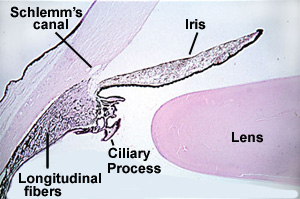| Ciliary process details:
Identify the heavily pigmented choroid layer surrounding the retina (Fig. 23-23).
- Follow this
anteriorly and note the ciliary body (Fig. 23-5).
- Identify smooth
muscle in the ciliary body, projecting ciliary processes, and
remnants of the zonule or suspensory ligaments.
- At the limbus, near
where the ciliary body and iris join the cornea, identify the
endothelium-lined spaces of the canal of Schlemm (Fig. 23-6).
List three functions of the ciliary body.
What is the functional relationship between the ciliary processes
and the canal of Schlemm?
 Why is the zonule seldom seen intact on microscope slides? Why is the zonule seldom seen intact on microscope slides?
Clinical note: Glaucoma
results from the decreased outflow of aqueous humor through the
trabecular meshwork and the canal of Schlemm. This elevates
intraocular pressure, which can damage peripheral areas of the
retina and cause progressive loss of vision. Various medications can
lower the pressure and laser surgery can be used to improve drainage
through the trabecular meshwork. To the right is how person with
glaucoma sees the world.
The lens is next. |